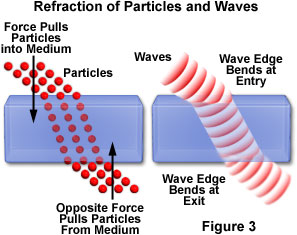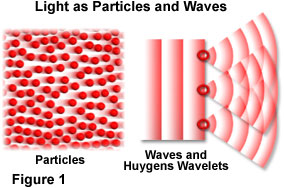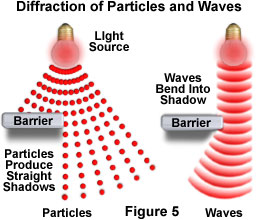The Particle Model Describes Light as
Here is a likely summary from most textbooks. Propagation reflection refraction dispersion.

Wave Particle Theory Ck 12 Foundation
There are rules within the particle model for each of the main three states of matter that you may already be aware of.

. The theory that describes matter in terms of particles is called the particle model of matter. Light behaves mainly like a wave but it can also be considered to consist of tiny packages of energy called photons. At times light behaves as a particle and at other times as a wave.
Light that vibrates in one direction is. As a metaphor consider a cylindrical can of beans. Light consists of particles known as photons and matter are made up of particles known as protons electrons and neutrons.
The wave theory and the particle theory of light were long considered to be at. Another interesting phenomenon is the Photoelectric effect now explained by the fact that light is a particle since it can also eject electrons with low intensity whereas it should not be able to following classical theory that light is a wave. The particle model of matter is a theory that explains how the particles that make up a substance are arranged and how they move and interact with each other.
It helps us to understand the macroscopic properties of a material in terms of the behaviour of the particles in that material. The particle model of light entails that light consists of tiny packages of energy called photons. Longer wavelength photons have less energy and shorter wavelength photons have more.
A stream of photons. Propagation reflection refraction dispersion S3P-2-08 Experiment to show the particle model of light predicts that the velocity of light in a refractive medium is greater than the velocity of light in an incident medium vr vi. H in E hf or E hc λ.
Energy of a photon formulas. Isaac Newton was the main advocate of the particle theory while James Clerk Maxwell and his. When a beam of light travels between two media having different refractive indices the beam undergoes refraction and changes direction when it passes from the first medium into the secondTo determine whether the light beam is composed of waves or particles a model for each can be devised to explain the phenomenon Figure 3.
This model states what solids liquids and gases are and explains the differences in their behaviour. He proposed that the propagation of light is caused by the rectilinear motion of light particles light corpuscles. The particle model of light entails that light consists of tiny packages of energy called photons.
If you hold the can sideways force a friend to only look at its shadow and ask him what shape the object has he will respond. Microwaves and radar are. There are a lot more phenomena but these are the most interesting ones I know.
But in an exact representation light is neither a particle nor a wave but is something more complex. Light can be described modeled as an electromagnetic wave. A discrete individual or separate amount.
In addition the present model describes light and material particle distributions in near- and far-field regions and in paraxial and nonparaxial approximations so that the paraxial Fourier and Wigner optics are included as particular cases in our more general model. In this model a changing electric field creates a changing magnetic. What is the particle model of light.
Light as a Particle. The particle model describes light as. These light particles travel at a finite speed and their interaction with the external environment eg.
Electromagnetic waves with the highest frequency are. This complementary or dual role for the behavior of light can be employed to describe all of the known characteristics that have been observed experimentally ranging from refraction reflection interference and diffraction to the results with polarized light and the photoelectric effect. Photons carry a fixed amount of energy but have no mass.
Electric magnetic and gravitational. E in E hf or E hc λ Planks constant in Js or eVs. Rigid surfaces walls and human eye obeys Newtonian physics.
S3P-2-07 Summarize the early evidence for Newtons particle model of light. E cross B G emphasizes the already known fact that the electric magnetic and gravitational force fields act at right angles to each other. Light can propagate through a vacuum as the wave nature.
S3P-2-07 Summarize the early evidence for Newtons particle model of light. On the other hand in particle nature light consists of elementary particles and these particlesphotons. A quantum particle of light energy.
One of the first topics I teach my pupils when they arrive in Year 7 11 years old is the particle model. S3P-2-08 Experiment to show the particle model of light predicts that the velocity of light in a refractive medium is greater than the velocity of light in an incident medium vr vi. The energy of a photon depends on its wavelength.
The Ball-of-Light Particle Model describes all elementary particles as standing spherical waves composed of three fields. Model of light and the particle model of light which together describe the wave-particle duality in which light is understood to possess both wave and particle functions. Light as a wave.
The history of science is marked by an intense debate between the particle and wave theories of light. Fits of observed single-electron and single-molecule interference patterns. E hf or E hc λ the energy in J or eV.
Everything around you is made of particles so tiny that we cannot see them even with the most powerful microscope. In an approximate way light is both a particle and a wave. The Particle Model.
The wave model of light is a concept that states light behaves as an electromagnetic wave whereas the particle model states that light consists of particles that are called photons. Objects that appear fuzzy through a material is. These extremely small particles are called atoms or molecules depending on the type of material.
Quantum theory describes that matter and light consists of minute particles that have properties of waves that are associated with them.
.jpg)
An Introduction To The Models Of Light

The Physics Of Color And Light Light Particle Or A Wave Olympus Ls

The Physics Of Color And Light Light Particle Or A Wave Olympus Ls

The Physics Of Color And Light Light Particle Or A Wave Olympus Ls
No comments for "The Particle Model Describes Light as"
Post a Comment